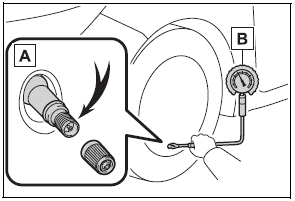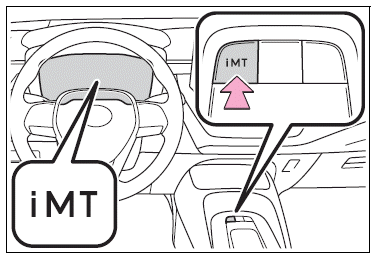Toyota Corolla: Tire inflation pressure / Inspection and adjustment procedure

A - Tire valve
B - Tire pressure gauge
1 Remove the tire valve cap.
2 Press the tip of the tire pressure gauge onto the tire valve.
3 Read the pressure using the gauge gradations.
4 If the tire inflation pressure is not at the recommended level, adjust the pressure. If you add too much air, press the center of the valve to deflate.
5 After completing the tire inflation pressure measurement and adjustment, apply soapy water to the valve and check for leakage.
6 Put the tire valve cap back on.
■ Tire inflation pressure check interval
You should check tire inflation pressure every two weeks, or at least once a month. Do not forget to check the spare.
■ Effects of incorrect tire inflation pressure
Driving with incorrect tire inflation pressure may result in the following:
- Reduced fuel economy
- Reduced driving comfort and poor handling
- Reduced tire life due to wear
- Reduced safety
- Damage to the drive train
If a tire needs frequent inflating, have it checked by your Toyota dealer.
■ Instructions for checking tire inflation pressure
When checking tire inflation pressure, observe the following:
- Check only when the tires are cold. If your vehicle has been parked for at least 3 hours or has not been driven for more than 1 mile or 1.5 km, you will get an accurate cold tire inflation pressure reading.
- Always use a tire pressure gauge. It is difficult to judge if a tire is properly inflated based only on its appearance.
- It is normal for the tire inflation pressure to be higher after driving as heat is generated in the tire. Do not reduce tire inflation pressure after driving.
- Never exceed the vehicle capacity weight. Passengers and luggage weight should be placed so that the vehicle is balanced.
WARNING
■ Proper inflation is critical to save tire performance
Keep your tires properly inflated. If the tires are not properly inflated, the following conditions may occur which could lead to an accident resulting in death or serious injury:
- Excessive wear
- Uneven wear
- Poor handling
- Possibility of blowouts resulting from overheated tires
- Air leaking from between tire and wheel
- Wheel deformation and/or tire damage
- Greater possibility of tire damage while driving (due to road hazards, expansion joints, sharp edges in the road, etc.)
NOTICE
■ When inspecting and adjusting tire inflation pressure
Be sure to put the tire valve caps back on.
If a valve cap is not installed, dirt or moisture may get into the valve and cause an air leak, resulting in decreased tire inflation pressure.
 Tire inflation pressure
Tire inflation pressure
Checking the specified tire inflation pressure
The recommended cold tire inflation pressure and tire size are displayed on the
tire and loading information label...
 Wheels
Wheels
If a wheel is bent, cracked or heavily corroded, it should be replaced. Otherwise,
the tire may separate from the wheel or cause a loss of handling control...
Other information:
Toyota Corolla 2019-2026 Owners Manual: Points to remember
The laws of all 50 states of the U.S.A. as well as Canada now require the use of child restraint systems. Prioritize and observe the warnings, as well as the laws and regulations for child restraint systems. Use a child restraint system until the child becomes large enough to properly wear the vehicle’s seat belt...
Toyota Corolla 2019-2026 Owners Manual: Vehicle signature settings
1 Select “Vehicle Signature” 2 Select the desired item to be set. A - Select to set adding the vehicle signature to outgoing messages on/off. B - Select to edit the vehicle signature. C - Select to reset all setup items. ■ Editing vehicle signature 1 Select “Edit Vehicle Signature”...
Categories
- Manuals Home
- 12th Generation Corolla Owners Manual
- Odometer and trip meter display
- Air conditioning controls
- Electric parking brake
- New on site
- Most important about car
iMT (Intelligent Manual Transmission)
The iMT optimally controls the engine speed to suit the driver’s operation of the clutch pedal and shift lever, helping the driver to shift gears more smoothly. Additionally, when the clutch pedal is operated, the iMT helps reduce shift shock, allowing for lighter shift operations when driving on a winding road or incline.
Press the “iMT” switch.

